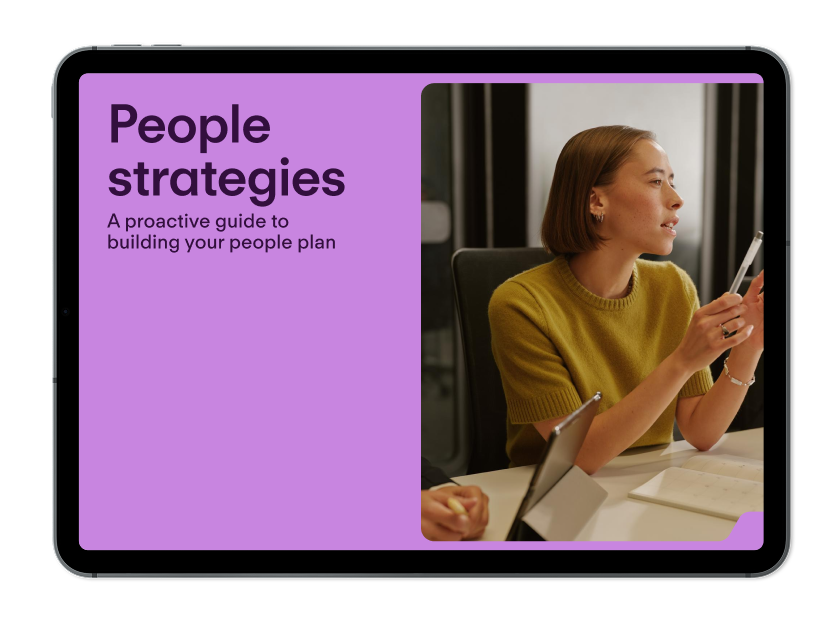
People Strategy Guidebook
A free guide to help power your next great people strategy.
Download our guide to developing your organization’s own people strategy today.How To Improve Health And Wellbeing In The Workplace

It goes without saying that HR leaders should care about health and wellbeing in the workplace. But, how can they make it real and what actions can they take? In this article, we offer a hands-on guide to wellbeing in the workplace that we think you'll find useful.
All of your employee data, all in one secure place. Learn more today.What Is Health And Wellbeing In The Workplace?
Health and wellbeing in the workplace is a broad term that can cover everything from an employee’s physical health to their personal development, social connectedness, emotional, and psychological health, and even, depending on your company’s perspective, their financial health.
Why Is Health and Wellbeing Important for HR?
For HR, health and wellbeing in the workplace requires a holistic approach. Employee wellness now goes far beyond reducing sick leave (although that’s still important) to addressing – and preventing – the root causes that might be at play.
Fostering good employee health and wellbeing in the workplace isn’t just good for employees, though, it’s good for the whole company.
The CIPD states that "investing in employee wellbeing can lead to increased resilience, better employee engagement, reduced sickness absence, and higher performance, and productivity."
What Is Corporate Wellbeing?
What’s the difference between employee health and wellbeing, and corporate wellbeing? Corporate wellbeing is the actual program (or programs) that a company uses to encourage healthier lifestyle choices, behaviour, or attitudes in their workforce.
Formal corporate wellbeing programs can include:
Spiritual wellness initiatives like the use of meditation apps.
Emotional wellness support such as employee assistance programs that encourage employees to speak to someone, openly – but outside of the organization – to help them cope when times are tough.
Environmental wellness offerings like providing days off for teams to support the community, build new homes, restore the environment, or contribute to society as a whole.
Social wellness activities such as putting policies in place designed to reduce the pressure on employees so they aren’t expected to respond to emails outside of office hours.
Intellectual wellness initiatives including the resources or funding for employees to do further study or training.
Occupational wellness opportunities such as the ability for employees to set their own SMART (specific, measurable, achievable, realistic, and time-bound) goals that challenge them, as well as fitting within overarching company objectives.
Physical wellness activities, which is the one that comes to mind first when people typically consider what a corporate wellbeing program might focus on.
Why Does It Matter?
First and foremost, looking after employees isn’t just a nice-to-have. It is well established that happier employees are more productive: Which can contribute directly to business success.
Additionally, in the UK, many aspects of employee wellbeing are also enshrined in law. UK employment law covers various health and wellbeing aspects including;
Health and safety at work
Workplace pensions
Protected leave (like parental, carers’ and adoptive leave)
The good news is that, according to the CIPD’s Health and Wellbeing at Work 2021 survey, organizations are paying more attention to their employees’ wellbeing than ever before. The survey reveals that three quarters (75%) of respondents believe that senior leaders have employee wellbeing on their agenda, up from 61% last year.
Managers are paying more attention to their employees’ health and wellbeing, too. The same research revealed that that two-thirds (67%) of line managers are bought into the importance of wellbeing, up from 58% last year.
Dive Even Deeper Through Our People Strategy Guide

Gain insights directly from Personio's Chief People Officer on how to build a better people strategy roadmap today. Grab your copy, for free, right now.
Download For FreeWhat Are Examples Of Health And Wellbeing At Work?
Looking back at the various types of corporate wellbeing programs that can be used, the CIPD recommends focusing on these seven underlying elements that all workplace initiatives share.
Looking after our health.
Doing good work.
Having clear values and principles.
Helping employees feel like they’re part of something.
Giving employees a chance to grow, personally.
Promoting good lifestyle choices.
Helping maintain employees’ financial wellbeing.
It’s easy enough to see examples of how organizations help promote effective health and wellbeing at work – or where they might fail.
For example, when it comes to physical health – HR should provide the basics, such as health checks, benefits, health insurance, and employee assistance programs.
There’s also a legal requirement to ensure companies have safe working practices, equipment, and appropriate safety training. It’s also becoming increasingly obvious that good employers also need to help look after employees’ mental health.
A good employee assistance program goes a long way – but it’s also wise for HR leaders to consider whether to offer training like stress management, conflict resolution, or how to have difficult conversations.
More often than not, addressing behaviour that can cause unhappiness at work in the first place goes a long way towards preventing future distress.
Dive Even Deeper Through Our People Strategy Guide

Gain insights directly from Personio's Chief People Officer on how to build a better people strategy roadmap today. Grab your copy, for free, right now.
Download For FreeWhat Role Does HR Play In Corporate Wellbeing?
While HR does have a responsibility to provide the structures, rules, guidance, initiatives, policies, and frameworks that look after employees’ health and wellbeing at work, their scope to put corporate wellbeing initiatives in place varies significantly from company to company.
In many cases, HR must collaborate with other departments, leaders, and even consultants to turn great ideas into workable initiatives that help improve career development, personal development, and inclusiveness.
In other cases, companies may choose to outsource some or all of these services (and others, too) to a Professional Employer Organization (PEO) that can provide the HR services that an internal team would usually provide, externally.
Dive Even Deeper Through Our People Strategy Guide

Gain insights directly from Personio's Chief People Officer on how to build a better people strategy roadmap today. Grab your copy, for free, right now.
Download For FreeHow Do You Create Corporate Wellbeing Programs For Employees?
It’s important to remember that a wellbeing program doesn’t have to be complicated or expensive.
Here are some great ideas for how to create wellbeing programs for employees:
Find Subject Matter Experts | Ask experts to volunteer their time to train others in their areas of expertise (you might be surprised what people enjoy learning about in their spare time, and are willing to talk about). |
|---|---|
Exercise Programs | Encourage employees to set up sports, or exercise groups that meet regularly, inside, or outside of office hours. |
Support For Social Programs | Provide support for corporate social responsibility initiatives like community projects. Even if you can’t pay for resources, allowing time off for employees to do this during work hours fosters goodwill. (It can also improve employee loyalty and psychological safety). |
Ask For Ideas | The very act of asking them to contribute already fosters a sense of inclusiveness. And, if it’s important enough for employees to do, they’ll often find a way to do it that doesn’t cost a lot of money or require a lot of commitment from HR. |
There are probably many more ways your organization can create wellbeing programs that serve the needs of your employees. So give them a try! There’s no harm in letting employees come up with ideas if you have the intention (and, ideally, a meaningful budget) to support them.
Corporate Wellbeing Best Practice: Be Creative!
Remember, motivated employees perform better. Sometimes having a challenge or restriction can actually improve creativity – as well as helping people feel connected, filled with purpose, and as if their company cares about them.
At the end of the day, that’s what employee health and wellbeing is all about.
